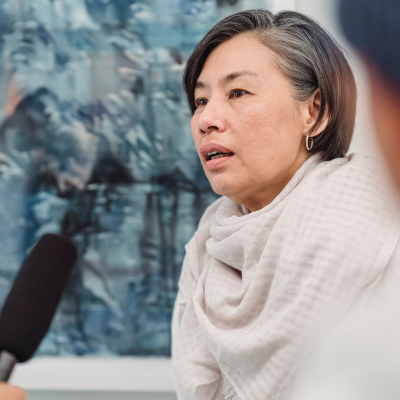Navigating Disclosures of Addiction Stories in the Digital Age
Our personal narratives possess the unique power to transform a listener’s perspective, turning empathy into action and pain into purpose. When stewarded with care, stories uplift and illuminate the often-misunderstood realities of addiction, breaking through the barriers of stigma to spark better understanding and stronger support for the empathetic treatment of substance use disorders. But these same stories also have the potential to further stigmatize, stereotype and disempower when not stewarded appropriately, undermining the individual and those impacted.
Historically, personal narratives have proven instrumental. The AIDS/HIV movement, for example, used personal stories to create understanding and empathy. Yet, in today’s interconnected era, sharing holds potential risks alongside its rewards and the true challenge lies in deciding whether, how, and when to share such narratives, especially in the digital age.
What’s the Pull to Share One’s Story?
Stories have always been a cornerstone of human communication, originating as visual depictions etched into rock, shifting into oral traditions told around campfires and then written into letters and books. Today stories are almost exclusively transformed digitally, and able to traverse the globe instantaneously. Let’s reimagine conventional campaigns addressing alcohol and other substances, shaping them into adaptable and compassionate pillars of hope for individuals navigating the complex terrain of substance use challenges. Sharing experiences, especially those of struggle and triumph, can forge connections, offer solace, and inspire change.
For individuals in recovery, articulating their journey can serve as a therapeutic exercise, reinforcing their commitment to recovery and offering hope to others in similar situations. We see the enduring legacy of mutual aid groups and 12-step programs deeply rooted in the art of storytelling; anonymously exchanging stories serves as a form of shared strength in recovery, while simultaneously fostering comradery and connection. For those recovering from addiction, the motivations are diverse: to inspire others, effect societal change (a movement ignited by Greg Williams’ Anonymous People), succumb to perceived pressures, make amends or even seek redemption. However, these stories often emerge publicly during early recovery, a period marked by vulnerability and fail to offer the same safety experienced in anonymous spaces.
Stigma Rears its Ugly Head
Sharing personal stories in the digital age introduces a myriad of ethical complexities. The digital landscape democratizes storytelling, yet the vast reach and permanence of the internet can solidify these narratives, at times to the detriment of the individual sharing.
The societal stigma surrounding addiction is deeply entrenched. The World Health Organization identifies drug use as the most stigmatized condition worldwide, and alcohol use isn’t far behind. Personal disclosures about substance use can amplify this stigma, resulting in discrimination, negative reactions, and exclusion for an often-limitless amount of time.
Choosing to disclose one’s addiction journey online is a personal decision with potential far-reaching consequences. Opportunities may be lost, housing applications denied, parental rights questioned, and relationships strained. These consequences are only magnified based on one’s positionality; individuals from other marginalized groups, ethnicities, or identities may experience a compounding effect when it comes to facing discrimination. In our digital era, forgetting is a thing of the past; an individual’s public image can become inextricably linked to their addiction story, relegating them to a single narrative that persists long after their recovery advocacy.
Beyond the tangible repercussions, the act of sharing can take a significant mental and emotional toll. Revisiting traumatic experiences, especially in a public forum, can lead to re-traumatization. The risk of iatrogenic harm, where sharing intensifies trauma, looms large. In today’s context, sensationalized or oversimplified addiction stories can perpetuate stereotypes, further stigmatizing and disempowering both the individual and those with similar experiences. Moreover, our societal obsession with trauma voyeurism — the consumption of distressing content that depicts suffering — compounds these challenges; the unsettling fascination with witnessing pain can divert attention away from the genuine empathy and understanding these stories merit.
Moving Forward with “Real” Stories of Recovery
The truth is, the internet, with its vastness and anonymity, might not be the safest space for such disclosures. Unlike conditions like heart failure, addiction carries a unique societal weight, making public disclosures particularly risky. Individuals who want to share their stories publicly should be encouraged to take media training, such as the “Our Stories Have Power” training by Faces and Voices of Recovery. Even when individuals choose to use their recovery story as an advocacy tool, the stories can live on potentially well beyond their advocacy careers.
Additionally, using stories from individuals that have at least five years in recovery, the timeframe in which individuals achieve sustained remission, will ensure that the stories do not unintentionally leverage the vulnerability of individuals earlier on in their recovery journeys. Moreover, stories can convey equal authenticity even when only a first name, or an alias is used. Simply avoiding the use of an individual’s last name safeguards their privacy, shielding them from potential online searches by future employers or prospective acquaintances.
A safer approach might entail strategic sharing: using snippets, quotes, or samples with agreed-upon durations online. However, this method must acknowledge that mere excerpts often fail to capture the larger context of one’s addiction and recovery journey. This can result in an undue focus on one’s active addiction or journey to rock bottom, largely ignoring the less sensational stages of recovery and rebuilding.
Properly addressing addiction and recovery also demands narratives that are genuine and diverse. Every recovery journey is distinct. It’s vital to allow individuals to convey their experiences in ways that truthfully depict their progress while preserving their autonomy and identity beyond their health condition. To combat stereotypes, it’s vital to feature affirmative portrayals of marginalized groups such as those affected by substance use disorder, and employ imagery, narratives, and instances that authentically reflect the varied composition of the community; sharing stories becomes particularly potent and therapeutic for individuals from marginalized communities to counteract the negative stereotypes and deficit-based stories perpetuated by dominant culture.
Solutions journalism is a valuable tool in this context. Rather than merely spotlighting the issue, it highlights solutions, emphasizing the concrete steps individuals take towards recovery. This journalism style delves into the nitty-gritty of each solution, backed by evidence, yet acknowledges its limitations. By focusing on solutions, narratives are steered away from sensationalism and towards genuine, empowering stories, fostering understanding, empathy, and informed conversations on stigmatized health challenges like substance use disorder.
Finally, as we promote responsible sharing, there also must be an emphasis on responsible content consumption and stewardship. News outlets can readily honor requests for content removal and enforce limits, such as two years’ time, in which posts remain online before they are removed.
Narratives that Shine
Stories are the heartbeat of humanity; they have the power to heal wounds, inspire change, and bridge the chasm between knowledge and action. Narratives have always been a powerful tool in humanizing conditions, such as substance use disorders (SUD). But the digital realm is a double-edged sword. On one hand, it offers a platform for voices that might otherwise go unheard. On the other hand, it poses risks of perpetuation, misrepresentation, and commodification. As we navigate this intricate landscape, the well-being of those sharing their stories must remain front and center.
In our eagerness to share and connect, let’s not lose sight of the individuals behind the narratives, their dignity, and their right to control their own stories. This isn’t a call to stop sharing stories of addiction and recovery, but we do need to shine light on the iatrogenic harm of sharing these stories. By championing a culture of thoughtful, respectful sharing, and drawing from the principles of Solutions Journalism, we can begin to develop narratives that uplift and empower not only those sharing, but also those listening. “Real” stories of addiction and recovery are not mere anecdotes but testimonies to human strength and determination.




